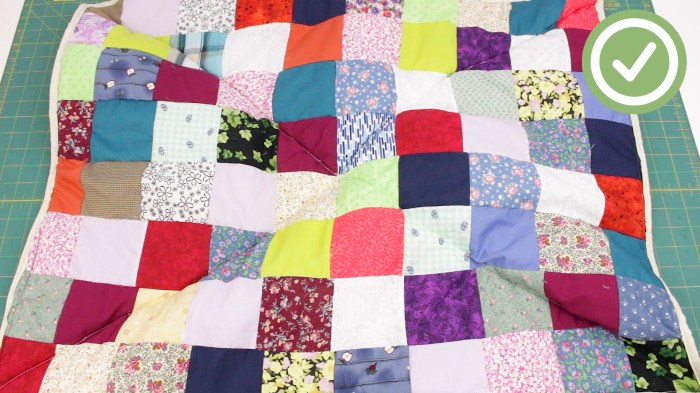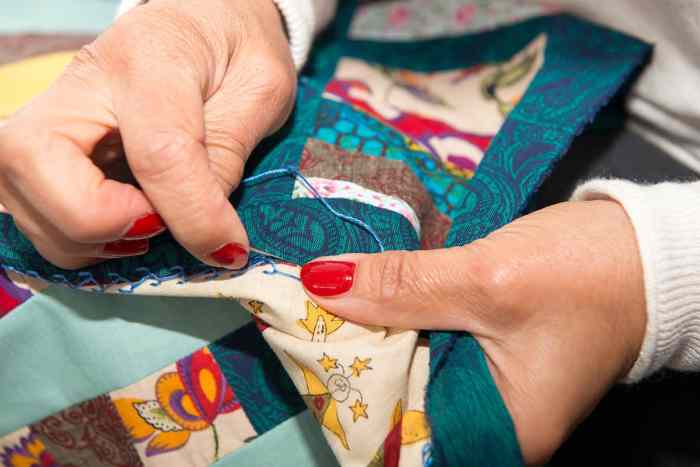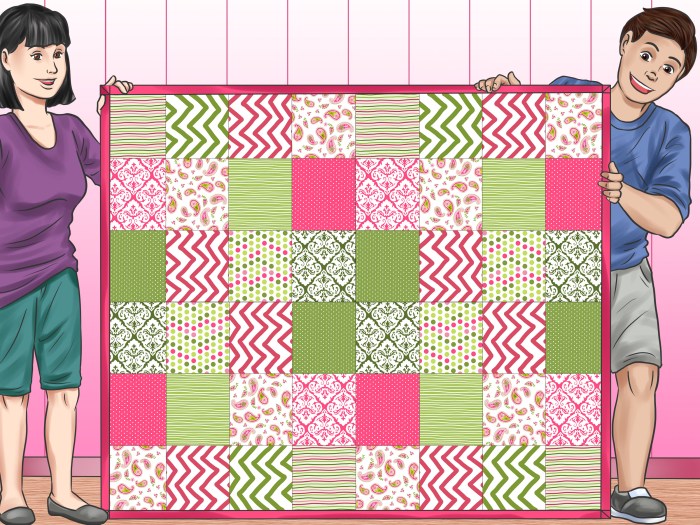DIY quilts, a blend of creativity and practicality, have surged in popularity as a beloved hobby and a rewarding creative outlet. The allure of DIY quilting lies in its therapeutic benefits, the sense of accomplishment that comes with completing a project, and the ability to personalize creations.
From crafting cozy blankets for loved ones to adorning homes with unique, handmade pieces, DIY quilting fosters a sense of community and connection among enthusiasts who share their passion and knowledge through workshops, online forums, and local quilting groups.
The Allure of DIY Quilts

The world of crafting is constantly evolving, with new trends emerging and old favorites experiencing a resurgence. Among these, DIY quilting has witnessed a remarkable rise in popularity, captivating both seasoned crafters and newcomers alike. This surge in interest is not merely a fleeting fad; it reflects a deeper cultural shift towards self-expression, mindfulness, and the pursuit of meaningful experiences.
Reasons for the Appeal of DIY Quilting
DIY quilting offers a unique blend of creativity, relaxation, and tangible results, making it an appealing hobby for a wide range of individuals. Here are some key reasons why this craft continues to captivate:
- Therapeutic Benefits: Quilting provides a meditative experience, allowing individuals to focus their attention on the repetitive motions of stitching and piecing fabric. This mindful engagement can be incredibly therapeutic, reducing stress and promoting a sense of calm.
- Sense of Accomplishment: Completing a quilt, from the initial design concept to the final binding, is a rewarding journey. The process involves a significant investment of time, effort, and creativity, resulting in a tangible masterpiece that reflects the maker’s skills and dedication.
- Personalization: DIY quilting offers endless possibilities for personalization. From selecting fabrics and patterns to incorporating personal touches like embroidered initials or meaningful symbols, quilters can create unique pieces that reflect their individual style and stories.
Community and Connection
Beyond the individual benefits, DIY quilting fosters a strong sense of community among enthusiasts.
- Shared Passion: Quilting groups and online forums provide spaces for individuals to connect with like-minded crafters, share their projects, and exchange tips and techniques. This shared passion creates a sense of belonging and camaraderie.
- Generational Legacy: Quilting often carries a generational legacy, with techniques and patterns passed down through families. This tradition creates a connection to the past and fosters a sense of continuity.
- Acts of Love: Quilts are often made as gifts for loved ones, symbolizing warmth, comfort, and care. This act of creating something special for another person strengthens bonds and creates lasting memories.
Quilt Design and Inspiration
Designing a quilt is a journey of creativity, where you translate your vision into a tangible piece of art. Whether you’re a seasoned quilter or a beginner, the possibilities for quilt designs are endless. Let’s explore the diverse world of quilt designs and where you can find inspiration for your next masterpiece.
Traditional Quilt Designs
Traditional quilt designs are often characterized by their classic patterns and symmetrical arrangements. These designs have been passed down through generations, reflecting the heritage and craftsmanship of quilt-making. Some popular traditional quilt designs include:
- Log Cabin: This pattern, with its simple yet striking design, features strips of fabric arranged in a spiral pattern, resembling a log cabin. The log cabin pattern was popular in the 19th century, as it allowed quilters to use up scraps of fabric efficiently.
- Star: Star patterns are timeless and versatile, featuring geometric shapes that radiate outwards from a central point. They can range from simple four-pointed stars to intricate designs with multiple points and layers.
- Nine Patch: The nine-patch pattern is a classic block design, composed of nine equal-sized squares, which can be arranged in various configurations to create different patterns. Its simplicity makes it ideal for beginners, while its versatility allows for endless variations.
Modern Quilt Designs
Modern quilt designs emerged in the late 20th century, breaking away from traditional conventions and embracing contemporary aesthetics. They often feature bold colors, geometric shapes, and minimalist designs. Modern quilts are known for their clean lines, abstract patterns, and unexpected color combinations. Here are some key features of modern quilts:
- Geometric Shapes: Modern quilts often incorporate geometric shapes like squares, triangles, and circles, arranged in unique and unexpected ways. These shapes create a sense of structure and visual interest.
- Negative Space: Modern quilters often embrace negative space, allowing the background fabric to play a significant role in the overall design. This technique can create a sense of balance and visual intrigue.
- Bold Color Combinations: Modern quilts are known for their bold and unexpected color combinations. Quilters often experiment with contrasting hues, creating a vibrant and dynamic aesthetic.
Contemporary Quilt Designs
Contemporary quilt designs are characterized by their innovative techniques, experimental materials, and artistic expression. They push the boundaries of traditional quilt-making, incorporating diverse artistic influences and contemporary trends. Some examples of contemporary quilt designs include:
- Free-Motion Quilting: This technique involves using a free-motion quilting foot on a sewing machine to create intricate and flowing designs. It allows for a greater degree of creativity and freedom of expression.
- Art Quilts: Art quilts are often considered fine art, showcasing the artist’s personal vision and expression. They can incorporate various techniques, materials, and themes, pushing the boundaries of traditional quilt-making.
- Mixed Media Quilts: Contemporary quilters often incorporate mixed media elements into their designs, combining fabrics with other materials like paper, thread, beads, and found objects. This approach creates unique and textured pieces that blur the lines between art and craft.
Finding Inspiration
The world of quilt design is brimming with inspiration. Here are some resources and platforms where you can find ideas for your next quilt project:
- Quilt Magazines: Quilt magazines are a treasure trove of quilt patterns, tutorials, and inspiration. They often feature interviews with renowned quilters and showcase the latest trends in quilt design.
- Online Quilt Communities: There are numerous online communities dedicated to quilting, where quilters can connect, share their work, and find inspiration. These communities offer a platform for learning, collaboration, and creative exchange.
- Quilt Shows and Exhibits: Attending quilt shows and exhibits is a fantastic way to experience the diverse world of quilt design firsthand. You can see a wide range of quilts, from traditional to contemporary, and gain insights into the techniques and styles of different quilters.
- Social Media: Social media platforms like Instagram, Pinterest, and Facebook are excellent sources of inspiration for quilt design. You can follow quilters, explore hashtags related to quilting, and discover new patterns and techniques.
Quilting for Different Occasions: Diy Quilt

Quilts are not just for warmth and comfort; they are also cherished gifts that can be tailored to celebrate special moments in life. Whether it’s a birthday, a wedding, or a holiday, a handmade quilt can add a personal touch and create a lasting memory.
Birthday Quilts
Birthday quilts are a delightful way to celebrate a loved one’s special day. They can be whimsical and playful for children or elegant and sophisticated for adults.
Here are some ideas for birthday quilt designs:
- For children: Consider bright, colorful fabrics featuring characters from their favorite books or movies. Appliqué shapes like animals, balloons, or numbers can add a personalized touch.
- For adults: Choose fabrics in colors and patterns that reflect their hobbies or interests. For example, a quilt for a gardening enthusiast could feature floral prints or a quilt for a music lover could incorporate musical notes or instruments.
Wedding Quilts
Wedding quilts are often treasured family heirlooms, symbolizing the union of two lives. They are typically made in elegant colors and patterns, often incorporating lace or other delicate embellishments.
Here are some tips for designing wedding quilts:
- Fabric Selection: Choose fabrics in colors that complement the wedding theme and the bride’s wedding dress. Consider using white, ivory, or soft pastel shades.
- Patterns: Traditional wedding quilt patterns include the “Double Wedding Ring” and the “Friendship Star.” These patterns are often intricate and symbolize the joining of two lives.
- Personalization: Consider adding the couple’s initials or wedding date to the quilt with embroidery or appliqué.
Holiday Quilts
Holiday quilts are a festive way to decorate your home and create a cozy atmosphere. They can be made in traditional holiday colors like red, green, and gold, or incorporate whimsical patterns that evoke the spirit of the season.
Here are some ideas for holiday quilt designs:
- Christmas Quilts: Use fabrics with Christmas-themed patterns like snowflakes, reindeer, and Santa Claus. Consider adding a border of red and green fabric or a festive appliqué of a Christmas tree.
- Halloween Quilts: Use fabrics with spooky patterns like bats, ghosts, and pumpkins. Consider adding a border of black and orange fabric or an appliqué of a witch’s hat.
- Thanksgiving Quilts: Use fabrics with autumnal patterns like leaves, pumpkins, and turkeys. Consider adding a border of brown and orange fabric or an appliqué of a cornucopia.
Exploring Advanced Quilting Techniques

Once you’ve mastered the basics of quilting, you might find yourself eager to explore more intricate designs and techniques. Advanced quilting techniques allow you to create stunning quilts that showcase your creativity and skill. These techniques involve specialized tools and techniques, and often require patience and practice to master.
Free-Motion Quilting
Free-motion quilting, also known as “stitch in the ditch” or “freehand quilting,” allows you to create free-flowing designs directly onto your quilt. This technique involves using a free-motion quilting foot, which allows the fabric to move freely under the needle. The quilter can then create intricate designs, such as swirls, loops, and meandering lines, without being confined to straight lines or grids.
Free-motion quilting requires practice and a steady hand, but it allows for a high level of creativity and personalization.
“Free-motion quilting is a great way to add a personal touch to your quilts. You can create designs that reflect your unique style and personality.”
Appliqué
Appliqué is a technique that involves sewing or fusing fabric shapes onto a background fabric. This technique allows you to create intricate designs and details, such as flowers, animals, or geometric patterns.
There are several different appliqué techniques, each with its own unique look and feel. Some common techniques include:
- Needle-turn appliqué: This technique involves hand-sewing the edges of the appliqué shapes to the background fabric, creating a precise and detailed finish.
- Machine appliqué: This technique involves using a sewing machine to sew the appliqué shapes to the background fabric. This method is faster than hand-sewing, but it may not be as precise.
- Fusible appliqué: This technique involves using fusible webbing to attach the appliqué shapes to the background fabric. This method is quick and easy, but it may not be as durable as other techniques.
Appliqué is a versatile technique that can be used to create a wide variety of quilt designs.
Fabric Manipulation
Fabric manipulation techniques involve altering the texture and appearance of fabric to create unique effects. This can be done using a variety of techniques, such as:
- Batik: This technique involves applying wax to fabric to resist dye. The wax creates intricate patterns that can be further enhanced with different colors and techniques.
- Shibori: This technique involves folding, tying, or stitching fabric to create resist patterns before dyeing. The resulting designs are often geometric and abstract.
- Sashiko: This Japanese technique involves stitching small running stitches through fabric to create decorative patterns. Sashiko is often used to create quilts with a traditional Japanese aesthetic.
Fabric manipulation techniques can add depth and dimension to your quilts, making them truly unique and one-of-a-kind.
Quilting as a Gift
A handmade quilt is more than just a piece of fabric; it’s a tangible expression of love, care, and creativity. Quilts have been cherished for generations as symbols of warmth, comfort, and enduring memories. Giving a quilt as a gift is a truly special gesture that demonstrates your thoughtfulness and dedication to the recipient.
The act of crafting a quilt involves countless hours of dedication, meticulous stitching, and heartfelt intention. Each stitch represents a piece of your love and a desire to create something beautiful and meaningful for the recipient. This makes quilts a perfect gift for various occasions, such as weddings, birthdays, baby showers, or even just to express your appreciation for someone special.
Designing Personalized Quilts
One of the most beautiful aspects of quilting is the ability to personalize each creation. You can incorporate the recipient’s favorite colors, patterns, and themes into the design, making the quilt a unique and cherished treasure.
- Incorporate Personal Touches: Consider adding elements that hold special significance for the recipient, such as their initials, a favorite quote, or a meaningful symbol.
- Theme-Based Designs: For a baby shower, create a quilt with playful animal motifs or a soothing color palette. For a wedding, incorporate the couple’s wedding colors or a pattern that reflects their shared interests.
- Memory Quilts: These quilts are a heartfelt tribute to loved ones, incorporating fabric scraps from cherished clothing, blankets, or other items that hold sentimental value.
Emotional Impact of Receiving a Handmade Quilt
Receiving a handmade quilt evokes a profound sense of love, care, and appreciation. The recipient feels cherished and valued, knowing that you poured your heart and soul into creating something special just for them.
“A quilt is a gift that keeps on giving. It’s a warm embrace on a cold night, a reminder of a loved one, and a testament to the enduring power of love and creativity.”
The emotional impact of a handmade quilt transcends the physical gift. It becomes a symbol of your connection, a treasured heirloom that will be passed down for generations, carrying with it the warmth of your love and the story of its creation.
Preserving and Displaying Quilts
A handmade quilt represents a significant investment of time, effort, and love. To ensure its longevity and beauty, it’s crucial to prioritize proper storage and care. This involves understanding the delicate nature of the materials used and implementing strategies that minimize wear and tear.
Preserving Quilts
Proper storage and care are essential for preserving the quality and beauty of your quilts. Here are some tips:
- Store in a cool, dry place: Avoid storing quilts in attics, basements, or garages where temperatures and humidity levels fluctuate greatly. These conditions can lead to mold, mildew, and fabric deterioration. Opt for a well-ventilated closet or a dedicated storage area with consistent temperature and humidity control.
- Use acid-free materials: Acidic materials like newspaper or cardboard can damage the fabric over time. Use acid-free tissue paper or muslin fabric to wrap your quilts for storage. This helps prevent discoloration and stains.
- Avoid direct sunlight: Prolonged exposure to sunlight can fade the colors and weaken the fabric of your quilts. Store them in a dark or dimly lit area to preserve their vibrancy.
- Rotate quilts: Regularly rotate your quilts to prevent creases from forming. This ensures even wear and tear on all areas of the quilt.
Washing and Drying Quilts
Washing and drying quilts require special care to prevent damage. Here are some guidelines:
- Check the care label: Always refer to the care label on your quilt before washing it. Some quilts may require dry cleaning or hand washing.
- Use a gentle detergent: Use a mild, pH-neutral detergent specifically designed for delicate fabrics. Avoid harsh chemicals or bleaches that can damage the fabric.
- Wash in cold water: Cold water helps preserve the colors and fibers of the quilt. Avoid hot water, which can cause shrinkage or fading.
- Wash separately: Wash the quilt separately from other laundry items to prevent snagging or damage.
- Dry on low heat: Dry the quilt on a low heat setting in a dryer or air-dry it flat on a clean surface. Avoid high heat, which can cause shrinkage or damage the fabric.
Displaying Quilts, Diy quilt
Displaying quilts allows you to showcase their beauty and appreciate their craftsmanship. Here are some methods:
- Hanging on walls: Hanging quilts on walls is a popular method for displaying them. Use quilt hangers or rods designed for hanging quilts. Ensure the hangers are securely attached to the wall and can support the weight of the quilt.
- Using quilt racks: Quilt racks provide a decorative and functional way to display quilts. They come in various styles and sizes to accommodate different quilt dimensions.
- Rotating displays: Consider rotating your quilt displays to showcase different pieces throughout the year. This helps keep your quilts fresh and prevents any single quilt from experiencing excessive wear and tear.
Embarking on your DIY quilting journey is an enriching experience that allows you to express your individuality, create lasting keepsakes, and connect with a vibrant community of passionate crafters. Whether you’re a seasoned quilter or just starting, the world of DIY quilting offers endless possibilities for creativity, self-expression, and the joy of crafting beautiful and meaningful pieces.
DIY quilts are a great way to personalize your home and showcase your creativity. You can choose fabrics that reflect your style and create a unique piece of art. If you’re looking for a way to keep your home comfortable, you might also want to consider installing a MrCool DIY mini split. These systems are easy to install and can help you save money on your energy bills.
Once you’ve finished your quilt and installed your mini split, you’ll have a cozy and comfortable home that you can truly call your own.

